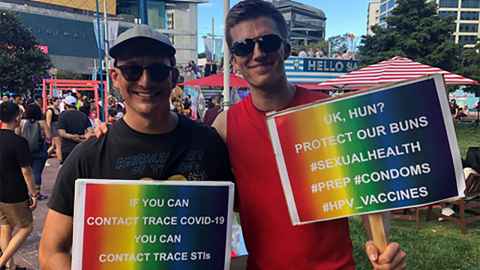Quiet and avoidable sexual health catastrophes
13 April 2021
Opinion: Basic information is missing, screening programmes are limited and people are dying. Peter Saxton lays out the problems with sexual health in this country.

Sexual health has been making headlines. The spotlight has been on human papillomavirus (HPV), our most common sexually transmitted infection (STI) and the causal agent of not only cervical cancer but also oral, anal and genital cancers that affect both men and women. People are rightly concerned about the limitations of current screening programmes and are asking questions about improving access to prevention tools like the HPV vaccine, which is free to all those aged nine to 26 years.
It’s another urgent example of why we need to de-stigmatise sex, sexuality and sexual health. Sex is an important part of many people’s lives. It can be intimate, pleasurable and fun. We shouldn’t accept patchy programmes where consecutive governments' continued neglect seems to take advantage of people’s embarrassment, vulnerability and reluctance to speak out.
And it’s not just HPV. Less common STIs like gonorrhoea and syphilis can cause serious health issues too. The latest data from Crown Research Institute ESR shows both are on the rise.
Gonorrhoea case rates increased a whopping 33 percent from the year ending 2018 to the year ending 2019, from 110 per 100,000 to 146 per 100,000. Rates rose in both men and women, and were highest in those aged 20-29 and among Māori and Pacific peoples. A quarter (26 percent) of cases reported in the 12 months to the end of 2019 were among gay and bisexual men. Gonorrhoea is becoming harder to treat and unless we develop an effective vaccine, humanity faces the painful prospect of super-gonorrhoea bugs.
Syphilis also increased 16 percent over the same period from 627 to 729 cases. That’s almost three jumbo jets of individuals every year, many of whom wouldn’t have been aware of their symptoms and continued being sexually active. And while the number dipped in the final quarter of 2019, largely due to better control in Auckland, it’s in the context of a 787 percent increase in syphilis in Aotearoa since 2013.
Gay and bisexual men account for an overwhelming 60 percent of syphilis cases. Tragically, in 2019 there were also five congenital cases (babies born with syphilis). Some babies have died. That’s due to unchecked transmission in young reproductive-aged women, a quiet avoidable catastrophe the sexual health sector has been raising the alarm over for years.
What we don’t know is also concerning. Basic information for over half (56 percent) the gonorrhoea cases is missing. Of the reported cases, 25 percent are missing vital information such as whether transmission occurred from heterosexual or homosexual contact. That fraction is now improving, but it could be concealing considerable inequities. For example, we’ve estimated that gonorrhoea could be up to 70 times more common in gay and bisexual men in than the general population.
As the saying goes, “You can’t manage what you don’t measure”. High quality infectious disease surveillance provides useful intelligence to public health decision-makers (e.g. Medical Officers of Health, DHBs, community organisations and individuals themselves) so they can act in a timely way, with laser-focused targeting. Conversely, big gaps in our surveillance picture create uncertainty, a lack of urgency and poorly directed responses that are insufficient to control spread.

It will probably surprise you to hear then that since 2017, gonorrhoea and syphilis have been legally notifiable under Section C of the Health Act 1956.
Three immediate changes would help bend these epidemic curves back.
First and most basically, it should be easy for a busy GP to find the notification form. We’ve written about this before. There’s been some progress since then, but it’s still an unnecessary obstacle with a simple fix.
Second, to minimise missing information, doctors should be incentivised to complete the form for gonorrhoea. Notification forms protect patient’s identity, but provide vital surveillance data for control, like sex of partners (male, female, both). Doing so is actually legally mandated in the Health Act s.156 and non-compliance carries a potential penalty of $500. Who’s responsible for ensuring doctors comply and why isn’t this happening?
Third, the government and DHBs should re-purpose Aotearoa’s Covid-19 contact tracing teams towards STIs. Associate Health Minister Dr Ayesha Verrall has highlighted the parallels between Covid-19 and HIV, especially stigma and asymptomatic infection. Since 2020, Kiwis have shown they’ll cooperate with skilled and sensitive contact tracing staff, even involving invasive, private matters. Especially if they feel safe doing so and see real benefits for their contacts and communities.
Other solutions include DHBs properly resourcing free sexual health services around the country. Clinical training needs to improve GPs' cultural competency to discuss a patient’s sexuality and sexual health history-taking. We’ve shown that half of gay men aren't out to their GP and screen for STIs less frequently than needed, presumably because of anticipated homophobia. GP consultations about sex and STIs ought to be as normal and shame-free as disclosing flu symptoms. Some GPs do this well, others not so much. Perhaps we need a patient-driven revolution demanding comprehensive non-judgmental and useful sexual health care at our next appointments?
Covid-19 has revealed to New Zealanders the value of high quality public health surveillance that’s followed by timely and effective action. Last year I suggested that Covid-19 lockdowns similarly provided us with a unique opportunity to stamp out undiagnosed STIs and HIV and break chains of transmission. I sense there’s still public appetite for centralised, comprehensive and coordinated public health responses, but how long will this last?
We can’t afford more ad hoc undirected inaction, especially when there are easy short-term wins and a public health framework designating accountabilities.
After all, public health is a field that prides itself on pragmatic and cooperative, not coercive, solutions: “The science and the art of promoting health, preventing disease and prolonging life through the organised efforts of society”. STIs are preventable and can be controlled. We just need the political will to fix this.
Dr Peter Saxton is the NZ AIDS Foundation Fellow at the University of Auckland Faculty of medical and Health Sciences.
This article reflects the opinion of the author and not necessarily the views of the University of Auckland.
Used with permission from Newsroom Quiet and avoidable sexual health catastrophes 13 April 2021.
Media queries
Alison Sims | Research Communications Editor
DDI 09 923 4953
Mob 021 249 0089
Email alison.sims@auckland.ac.nz